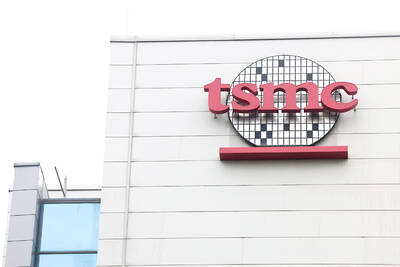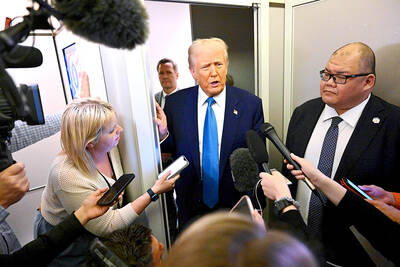Thanks to Intel Corp’s ultra-voltage (ULV) technology, notebook computers that are thin, lightweight and energy-efficient have prevailed at the just-closed Computex trade show in Taipei.
Abundant at the show were also ULV models that can support wireless transmission by using worldwide interoperability for microwave access (WiMAX) or wireless fidelity (Wi-Fi) technology.
With the support of major Taiwanese PC makers like Acer Inc (宏碁), Asustek Computer Inc (華碩), Gigabyte Technology Co (技嘉) and Micro-Star International Co’s (微星), Intel was seen as aggressively promoting the ULV platform last week.
But DRAMeXchange Technology Inc (集邦科技) said the US chip giant’s move was aimed at protecting its profitability in the traditional notebook market against erosion from the hot-selling netbooks, which were arguably made possible by Intel’s own Atom processors.
“Thin, lightweight models and long battery life should be the main focuses for the notebook industry in 2009,” Citigroup analyst Eve Jung (戎宜蘋) said last week.
She said that ULV models still had constraints to overcome if computer makers wanted to see stable revenue growth in the coming months.
Sean Maloney, Intel’s executive vice president and chief sales and marketing officer, set the tone for anticipated success in ULV notebooks during his opening speech at Computex on Tuesday, the same day the company introduced its latest ULV Core 2 Duo processors in Taipei.
“Enabled by ULV Core 2 Duo processors ... ULV notebook users are able to travel light, enjoy quality multimedia performance, as well as over seven hours of battery life at mainstream prices as low as US$499,” Maloney said.
He said ULV laptops would make up a major portion of the company’s sales volume as well as the entire global PC food chain.
Taipei-based market researcher DRAMeXchange said on May 13 the shipments of ULV notebooks would be between 8 million and 10 million units worldwide this year, accounting for between 7 percent and 9 percent of the traditional notebook market share.
Visitors to this year’s Computex could easily see the notebook market’s trend toward slim, light design and energy conservation.
President Ma Ying-jeou (馬英九) also had a chance to see the trends during a surprise visit to the Nangang exhibition hall on the last day of Computex on Saturday. He examined Micro-Star’s three ULV notebooks in its X-Slim series.
Asustek was aggressive in this segment as well, introducing five models of ULV notebooks during the show. The company said the products’ designers gained inspiration from the lightness of butterflies, although the machines still looked industrial due to their metal alloy casings.
Acer, which followed Asustek in launching netbooks two years ago, was among the first to introduce ULV notebooks this time. The company first unveiled its Aspire TimeLine ULV series in April, before introducing a full product line on May 21 with seven models with 13.3-inch, 14-inch and 15.6-inch screens.
“The ULV laptops will carve out a niche in the market but at the expense of desk-top PCs, not necessarily netbooks or traditional laptops,” Scott Lin (林顯郎), president of Acer’s Taiwan operations, said at the launch.
Acer forecast ULV notebooks would make up 20 percent of the global laptop market next year, with netbooks and traditional notebooks accounting for 20 percent and 60 percent respectively.
The company is likely to control 50 percent or more of the ULV notebook market, DRAMeXchange said.
Whether or not Acer can achieve its shipment target of between 5 million and 6 million units this year will depend on how it can solve the shortage of key components in the short term, the researcher said.
In a note to clients on Tuesday, Citigroup’s Jung said the ULV notebooks could become a major growth driver in the second half of the year, as major PC makers are planning to launch new models soon. Several company representatives said at Computex that they expected their products to hit the market sometime next quarter or early in the fourth quarter.
Component shortages, however, are likely to initially affect PC makers’ ability to offer a more complete product line, Jung said.
“How to secure sufficient supply of key components such as the third generation of double data rate memory chips, or DDR III, and light emitting diode backlight modules could be issues to watch,” she said in the note.
That may explain why Asustek and Micro-Star adopted the second-generation DDR memory chips, or DDR 2, rather than DDR 3 in their ULV models in the initial stage. But PC makers are facing other challenges, too.
“We think PC OEMs [original equipment manufacturers] and notebook ODMs [original design manufacturers] still have obstacles to overcome, especially in industrial design and production yield,” Jung said, referring to the slimmer design of ULV models.

When an apartment comes up for rent in Germany’s big cities, hundreds of prospective tenants often queue down the street to view it, but the acute shortage of affordable housing is getting scant attention ahead of today’s snap general election. “Housing is one of the main problems for people, but nobody talks about it, nobody takes it seriously,” said Andreas Ibel, president of Build Europe, an association representing housing developers. Migration and the sluggish economy top the list of voters’ concerns, but analysts say housing policy fails to break through as returns on investment take time to register, making the

NOT TO WORRY: Some people are concerned funds might continue moving out of the country, but the central bank said financial account outflows are not unusual in Taiwan Taiwan’s outbound investments hit a new high last year due to investments made by contract chipmaker Taiwan Semiconductor Manufacturing Co (TSMC, 台積電) and other major manufacturers to boost global expansion, the central bank said on Thursday. The net increase in outbound investments last year reached a record US$21.05 billion, while the net increase in outbound investments by Taiwanese residents reached a record US$31.98 billion, central bank data showed. Chen Fei-wen (陳斐紋), deputy director of the central bank’s Department of Economic Research, said the increase was largely due to TSMC’s efforts to expand production in the US and Japan. Investments by Vanguard International

WARNING SHOT: The US president has threatened to impose 25 percent tariffs on all imported vehicles, and similar or higher duties on pharmaceuticals and semiconductors US President Donald Trump on Wednesday suggested that a trade deal with China was “possible” — a key target in the US leader’s tariffs policy. The US in 2020 had already agreed to “a great trade deal with China” and a new deal was “possible,” Trump said. Trump said he expected Chinese President Xi Jinping (習近平) to visit the US, without giving a timeline for his trip. Trump also said that he was talking to China about TikTok, as the US seeks to broker a sale of the popular app owned by Chinese firm ByteDance Ltd (字節跳動). Trump last week said that he had

STRUGGLING TO SURVIVE: The group is proposing a consortium of investors, with Tesla as the largest backer, and possibly a minority investment by Hon Hai Precision Nissan Motor Co shares jumped after the Financial Times reported that a high-level Japanese group has drawn up plans to seek investment from Elon Musk’s Tesla Inc to aid the struggling automaker. The group believes the electric vehicle (EV) maker is interested in acquiring Nissan’s plants in the US, the newspaper reported, citing people it did not identify. The proposal envisions a consortium of investors, with Tesla as the largest backer, but also includes the possibility of a minority investment by Hon Hai Precision Industry Co (鴻海精密) to prevent a full takeover by the Apple supplier, the report said. The group is